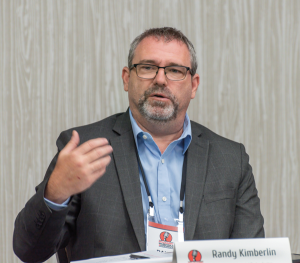Breaking down a supply chain like no other

Says Applied Industrial Technologies’ Randy Kimberlin: “When I call service centers or talk to someone in a service center and the general manager tells me he’s been on the phone for an hour or two trying to chase a piece of chain, that really affects our capacity and our ability to do what we’re trying to do.” Photo: PamElla Lee Photography
The following transcript was edited from a concurrent Pit & Quarry Roundtable & Conference discussion.
SEAN WEISIGER (CONN-WELD): We’ve increased our stock quite a bit. On the manufacturing side, every day is a new hurdle. I don’t care what it is. Raw materials are kind of stable as far as pricing goes, but it’s the finished goods that we can’t manufacture or machine in-house. With bearings, I think everybody’s fighting that same battle. I don’t care what kind of bearing it is. That’s been a struggle on the finished goods side that we can’t control.
RANDY KIMBERLIN (APPLIED INDUSTRIAL TECHNOLOGIES): When I call service centers or talk to someone in a service center and the general manager tells me he’s been on the phone for an hour or two trying to chase a piece of chain, that really affects our capacity and our ability to do what we’re trying to do, which is keep the producers up and running. When you can’t get it, that’s a problem. If it’s something that’s even more high tech like a semiconductor or integrated circuitry, it’s even worse. It’s multiples of multiples of weeks.
JOHN GARRISON (SUPERIOR INDUSTRIES): Like everybody else, we stocked up on the things you don’t make. It’s a moving target. It was gearboxes, now it’s electrical and every week it’s something else. There is a lot of hidden cost in there for manufacturers. When you have a finished piece of equipment that you’ve got hundreds of thousands of dollars invested in that’s sitting there waiting on a $500 or $1,000 part you can ship, and we have to wait three months before it can go, the customer’s upset.
KEATON TURNER (TURNER MINING GROUP): We’ve thrown all pricing evaluation out the window when it comes to buying decisions. It’s who has inventory and how quickly can we get it on-site. That’s just due to demand from our customer. In the years prior, it was all price driven or area of service. Now, we’re moving equipment from one side of the country to the other if it’s available.
BRIAN VRABLIC (RULMECA CORPORATION): You think you’ve got one thing figured out and the next thing pops up. Time inflation is the biggest problem. All our customers are used to faster. With shipping delays, we’re adding weeks. One of the ways that we’re trying to combat that is taking advantage of inexpensive money. We’re investing millions upon millions of dollars globally, including in the U.S., to insource a bunch of stuff that we would normally outsource to try and combat lead times. It’s not even about pricing anymore. It’s about lead times because we need it quicker.
VINNIE ROCCO (AMCAST): Bringing our wear parts over from Italy has been increasingly expensive and challenging as far as logistics is concerned. Crazy things are happening, like they won’t deliver us a container of parts because they can’t return an empty container at the port because there’s no one there to receive it. So now they’re holding our containers hostage. We can’t get them because they have no space to return them. You can’t even imagine or plan for something like that
NATE JENSEN (SENSATA TECHNOLOGIES): From a lead-time standpoint, we went from a three-day turnaround on standard fixed goods to six weeks over the course of about three months. Then that went to 18 weeks, and that was all due to incoming material and capacity constraints. The market demand is still very, very strong out there.

Conn-Weld’s Sean Weisiger says bearings have presented serious supply challenges, with just about every manufacturer fighting the same battles. Photo: PamElla Lee Photography
PATRICK WEAVER (L&H INDUSTRIAL): One thing we’ve seen that we expect to get more severe is, because of the supply chain challenges, it’s really forced companies like ours to shift our focus from manufacturing to repair. If we can fix it, we’re our customer’s best option right now because they know it will cost more to buy it. Companies like ours are trying to ramp up and keep people running. It’s tough because it fills your facilities up so you can’t manufacture. You have to charge premium dollars to do it, which is just fine now. People seem willing to pay that. But there will come a time when that stops. And if you have a facility full of used equipment, what do you do with it?
KAREN HUBACZ (BOND CONSTRUCTION CORP.): Manufacturers and distributors have been exceptionally proactive with producers, so we’re aware ahead of time how long things are going to take. That being said, if it’s financially feasible, we’re not buying one replacement part – we’re buying two. As producers, this is where we’re relying on each other because chances are I may have a spare. They will replace that for me and vice versa. There’s a lot more communication going on, which I think has really helped the industry immensely.
MATT LEPP (VDG): Before the pandemic, we put a lot of emphasis on moving as many of our processes in-house as possible, as well as making our supply chains as domestic as possible. The pandemic obviously expedited the growth of that program, and it saved us a lot. We’ve seen our lead times stay remarkably steady through all this as a result of that.









